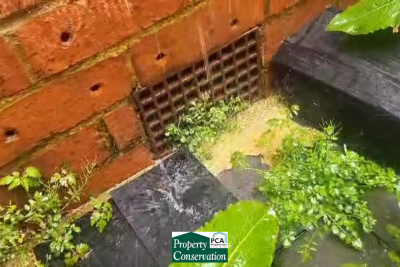Period properties like the one in the picture often have high ground level airbricks to allow a steady flow of air beneath the suspended wooden flooring. The reason for this is to protect ground floor timbers from damp problems by preventing a damp subfloor environment.
Oxfordshire has an abundance of old cottages, converted buildings and period homes with cellars that are most likely to suffer from damp problems caused by water ingress via these airbricks. Have a look at the video one of our waterproofing specialists took recently.
If water gets into your floor you risk rot
The specific damp problem on this customer’s home occurred when the guttering above the airbrick failed due to a blockage. The water overflowed, and the rain got into the wooden subfloor through the open airbrick.
You may be tempted to block or remove airbricks to prevent ground or rainwater entering your home, but we would strongly advise against this as you risk the structural integrity of the timbers in your home. Despite some claims that the effect of airbricks on subfloor atmospheres is negligible, the Property Care Association remains committed to their use.
Wet rot is the most likely form of damp problem that could occur in this situation, but this could lead to dry rot affecting your entire property. Both forms of timber rot are highly damaging to your home, so we advise that you carry out simple home maintenance to prevent something like this happening.
Check gutters, pointing and drains
Gutters provide a way to drain water away from your property quickly and without coming into contact with the structure. Even small blockages can become troublesome, so keep an eye on leaf collection and moss growth to ensure a clear passage for water.
Likewise, check for cracks, missing brackets or end caps and improper connections that may interrupt or redirect the flow of water towards your property.
Look for wet patches of stonework that could be a clue to damp problems through damaged pointing or where a broken gutter directs water onto the wall.
Keep drains, gullies and patios clear of leaves, grass cuttings and moss to allow the water to drain away freely, particularly in a heavy downpour. And ensure that your water butt has a well-fitting lid to prevent debris from clogging it up.
In this video from the inside of the property, you can see a clear passage of water from outside, to inside.
If you are concerned about the airbricks in your property or have noticed something that may cause water to get into your home and create damp problems, don’t hesitate to call for a free survey. One of our remedial surveyors will carry out a detailed survey of your property and report on the best course of action.

